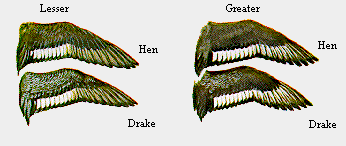Waterfowl Identification
Scaup

Greater Scaup (Aythya marila)
Identification Tips:
Length: 13 inches Wingspan: 31 inches
Small, compact diving duck
Rounded crown
Yellow eyes (brown in immatures)
Blue bill with black nail at tip
Dark wing with dark-tipped white secondaries and inner primaries and pale gray outer primaries
Immature female similar to adult female, immature male is similar to female in autumn, but acquires alternate plumage during winter
Adult male alternate:
Alternate plumage worn from fall through early summer
Glossy greenish head
Black breast
Whitish or pale gray flanks, white belly
Whitish back with fine black vermiculations
Black tail, upper- and under-tail coverts
Adult male basic:
Similar to adult female
Adult female:
Distinct white band around base of bill
Dark brown body plumage
Whitish belly
Similar species:
The Greater Scaup can be distinguished from the very similar Lesser Scaup by its larger size, wing stripe that extends well into the primaries, and glossy, greenish head as an adult male in alternate plumage. Adult male Ring-necked Duck similar in alternate plumage but has quite different bill pattern, black back, grayer flanks and vertical white finger just behind black breast. The Ring-necked Duck favors freshwater habitats while the Greater Scaup prefers brackish or saltwater habitats. Very rare Tufted Duck is similar but note the distinctive tuft at the rear of the head. When the tuft is not visible, adult males have black backs. Females are very similar but usually lack white band around base of bill and have more black at the tip of the bill. The female Redhead is very similar in shape and coloration to the female Greater Scaup but it lacks the white patch at the base of the bill and has a gray wing stripe.

Lesser scaup (Aythya affinis)
Identification Tips:
Length: 12 inches Wingspan: 29 inches
Small, compact diving duck
Peaked crown
Yellow eyes
Blue bill with small black nail at tip
Dark wing with dark tipped white secondaries and pale gray primaries
Immature female similar to adult female, immature male is similar to female in autumn, but acquires alternate plumage during winter
Adult male alternate:
Alternate plumage worn from fall through early summer
Glossy purplish head
Black breast
Whitish or pale gray flanks, white belly
Whitish back with fine black vermiculations
Black tail, upper- and under-tail coverts
Adult male basic:
Similar to adult female
Adult female:
Distinct white band around base of bill
Dark brown body plumage
Whitish belly
Similar species:
Adult male Ring-necked Duck similar in alternate plumage but has quite different bill pattern, black back, grayer flanks and vertical white finger just behind black breast. Greater Scaup is very similar but has a more rounded head, larger bill, dark-tipped white primaries and secondaries, and glossy, greenish head as an adult male in alternate plumage. Female Greater Scaup has more rounded head, a broader bill, and more white flight feathers, and frequently has a distinct pale spot behind eye on side of head.

Except for the wing marks, greater and lesser scaup appear nearly identical in the field. The light band near the trailing edges of the wings runs almost to the tip in the greater scaup, but only about half way in the lesser.

Greater scaup prefer large open water areas; lesser scaup often use marshes and ponds. Both species migrate late, sometimes just before freezeup. Flock movements are rapid, often erratic, usually in compact groups. Hens are silent; drake lesser scaup purr; drake greater scaup have a discordant scaup, scaup.





